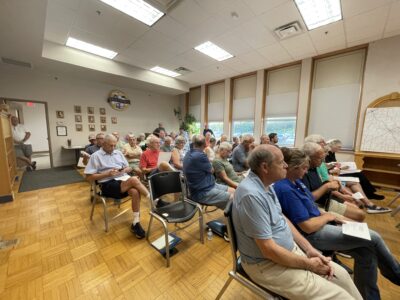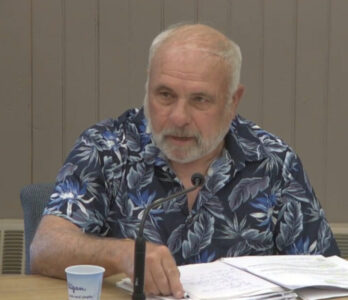Deer ‘impacts’ keep dogging village

OBSERVER Photo by M.J. Stafford Two deer wake up from a nap recently in Fredonia’s Pioneer Cemetery. A DEC biologist recently offered a presentation about the overpopulation of deer in the village.
Fredonia’s sizable deer population was the subject of a Department of Environmental Conservation wildlife biologist’s presentation at a recent Board of Trustees workshop.
Ryan Rockefeller said he was there at the invitation of Trustee Paul Wandel. Rockefeller offered a lengthy, information-heavy presentation with one big takeaway: Managing a deer population is a long-term effort.
He called deer a significant resource, but a significant source of damage. “In the last decade or so, we’re really starting to see the issues around the ecological impacts from deer overbrowsing our forests and causing issues in our ecosystems,” Rockefeller said. “The timber industry is definitely on the front line of noticing those impacts.”
He went over the local history of deer population swings. Prior to European colonization, the deer population was kept down by old growth forests with few open spaces and apex predators such as wolves. During the late 1700s and early 1800s, settlers killed off the large predatory animals and cleared large tracts of land, causing a surge in deer.
“That’s perfect deer habitat, when we open up the forest canopy and let some of the regeneration come up,” Rockefeller said. “That’s what deer thrive on.”
Later, by 1840, market hunting for venison increased to the point that the deer population crashed in the state. Deer were essentially absent from Western New York by 1860. However, laws passed in response to that which limited deer hunting helped begin a bounce-back that still continues.
“You can go from two deer to 40 deer in seven years if none of them die. … They literally function to outproduce the predators and the mortality they experience,” Rockefeller said. A local deer population must have 30-40% members of its population die every year to maintain stability, he said.
Deer are “browsing generalists.” They can thrive on many different food sources and can change sources throughout the year as conditions change. They must consume a lot to replace energy. Ecah deer eats an average of one ton of vegetation per year.
“They’re reproducing machines and they’re eating machines. Without being kept in check, they will quickly surpass their biological carrying capacity and ecological carrying capacity.” They are also past “social carrying capacity” in many places, including Fredonia, to the point where authorities get complaints that there are too many and they are causing damage.
Bears and coyotes do take some fawns but are not adequate apex predators, Rockefeller continued. The principal source of mortality for deer in developed areas without any hunting is collisions with vehicles.
The DEC offers regular recreational hunting seasons, but also issues deer management permits and extends hunting seasons in areas where deer population is high.
Rockefeller added that education is important, too, criticizing people who feed deer. “You get a couple bad actors that like to feed everything under the sun, and what they’re doing is training deer and habituating deer to human food sources and the presence of humans, so they’re not even fearful of us to stay away from our homes and our shrubs.”
While there is no such thing as a deer resistant plant because “deer will try anything once,” some plants are much less desirable to them than others.
Hunting would be inadequate to control deer in Fredonia on its own, due to property access issues and a relatively sizable human population, Rockefeller said. In response to a question from Mayor Michael Ferguson, Rockefeller said you have to be 500 feet from a landowner’s residence to hunt without permission but “you could hunt from their attic” if permission is given.
Many municipalities are using the deer management permit program to hire hunters that cull deer, Rockefeller said. Surgical sterilization is only effective and is expensive, but will cut the population — though the main way that happens in places without hunting is through vehicle strikes.
“Looking at the impacts would be more appropriate than just following the number of deer you have in the community,” he said.
Rockefeller pointed out that deer “properly taken” by a rifle usually die instantly while deer that are hit by cars suffer, often limping off and dying away from the collision site.
Trustee Jon Espersen asked about the success of culling in villages that are Fredonia’s size. “There’s been some that have tried it for a while but have stopped. I honestly can’t tell you how it might go,” Rockefeller said.
He noted that many suburban Buffalo areas have deer management programs that remove hundreds of deer every year, and some have been doing it since the 1990s. “They claim that it works,” he said. “What you’re really doing is replacing the hunting component, and then some.”
He noted that deer do get more skittish if they are hunted at some point in the year. “They may be looking at people as more of a threat or predator again.”
Responding to questions from Wandel, Rockefeller said there isn’t any kind of grant program for the deer management permits; said solar farms could cause a temporary surge in deer visits to human homes as they search for better areas to browse; and baiting is often used during culling to draw deer out into areas where they can be safely taken.





